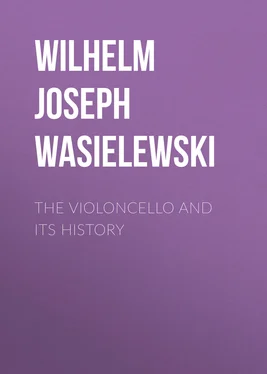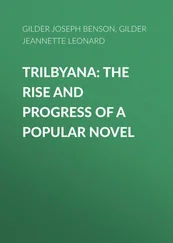Wilhelm Joseph von Wasielewski - The Violoncello and Its History
Здесь есть возможность читать онлайн «Wilhelm Joseph von Wasielewski - The Violoncello and Its History» — ознакомительный отрывок электронной книги совершенно бесплатно, а после прочтения отрывка купить полную версию. В некоторых случаях можно слушать аудио, скачать через торрент в формате fb2 и присутствует краткое содержание. Жанр: foreign_antique, foreign_home, music_dancing, на английском языке. Описание произведения, (предисловие) а так же отзывы посетителей доступны на портале библиотеки ЛибКат.
- Название:The Violoncello and Its History
- Автор:
- Жанр:
- Год:неизвестен
- ISBN:нет данных
- Рейтинг книги:3 / 5. Голосов: 1
-
Избранное:Добавить в избранное
- Отзывы:
-
Ваша оценка:
- 60
- 1
- 2
- 3
- 4
- 5
The Violoncello and Its History: краткое содержание, описание и аннотация
Предлагаем к чтению аннотацию, описание, краткое содержание или предисловие (зависит от того, что написал сам автор книги «The Violoncello and Its History»). Если вы не нашли необходимую информацию о книге — напишите в комментариях, мы постараемся отыскать её.
The Violoncello and Its History — читать онлайн ознакомительный отрывок
Ниже представлен текст книги, разбитый по страницам. Система сохранения места последней прочитанной страницы, позволяет с удобством читать онлайн бесплатно книгу «The Violoncello and Its History», без необходимости каждый раз заново искать на чём Вы остановились. Поставьте закладку, и сможете в любой момент перейти на страницу, на которой закончили чтение.
Интервал:
Закладка:
In opposition to this last somewhat sarcastic remark of Mattheson is what Gerber states a hundred years later (Vol. I., p. 6, of his “New” Musicians’ Lexicon) concerning the gamba. He there says: “It is remarkable in the history of music that his (Abel’s) instrument was buried with him in the year 1787 in total oblivion: the indispensable gamba, without which for a hundred years neither church nor chamber music could be arranged, which in all public and private concerts had the exclusive right to be heard before all other instruments from the beginning to the end, and which therefore, like caskets, must not only be exquisitely finished in every size, large and small, but was also ordered, bought, and paid for adorned with the most costly artistic carving—ivory, tortoiseshell, gold, and silver—then available. In the course of time there will be no vestige left in the whole of Europe of this instrument, once so universal and admired; henceforth it will have to be sought for amongst the old woodcuts in Prätorius, or specimens of it, stringless and worm-eaten, in a royal music chamber. Another sad proof how greatly Apollo is overruled by the goddess Fashion. The taste of our forefathers for these soft, modest, humming viola tones is also remarkable; they were a quiet, contented, peace-loving people! In the present time the instruments for our musicians cannot be chosen sufficiently high and shrill.” 42 42 What would Gerber have said had he lived to see the present demand for instruments required to make up an orchestra?
It is plain that although Gerber himself played the cello, this instrument was also known to him, and he had not only remarked the disproportion between the tone of the violins and those of the gambas in the orchestra with regard to strength, but also the circumstance that, by the creative faculty of Haydn and Mozart in the region of higher instrumental music, the gamba had become wholly superfluous. The superior qualities of the violoncello to the gamba as a solo instrument had escaped him, although the conspicuous success of cello players in the second half of the last century could not have remained unknown to him. It seems, therefore, as if Gerber had a special predilection for the gamba—a taste which only a few of his contemporaries shared with him.
Gerber’s 43 43 Gerber’s “Old Musical Lexicon,” p. 617, and Note, p. 86.
confident assertion that the French priest, Tardieu, of Tarascon, had invented the violoncello “in the year 1708,” is simply to be relegated to the region of fable, for the instrument had already existed long before in Italy. 44 44 In the preface to the violoncello tutor already mentioned, by Corrette, the untenable assertion is made that the violoncello was discovered by Bonocin (Buononcini), “preséntement Maître de Chapelle du Roi de Portugal.” A Bononcini, with the Christian name of Domenico, actually lived in 1737 at the Lisbon Court. At that period, according to Fétis, he must have been eighty-five years old. He must therefore have been born in 1652. He could not have invented the violoncello (if one could call it an invention), as it evidently existed before his birth. It is not even certain that Domenico Bononcini was a cellist. Possibly Corrette confounded him with Giov. Battista Bononcini mentioned later.
Fétis remarks (p. 47) in his article “Antoine Stradivari” (Paris, 1856): The violoncello had already been mentioned by Prätorius in his “Syntagma Mus.” (1614-1620), which is a mistake, for the work referred to contains neither the name nor the illustration of this instrument. 45 45 Another inaccuracy in Fétis’s “Stradivari,” p. 46, is that the name of violino “had already appeared in Lanfranco’s work ‘Scintille’ of 1533.” This announcement has caused some confusion. Before Lanfranco’s work was accessible to me, I also in bonâ fide had made the same assertion in my “History of Instrumental Music of the Sixteenth Century” (p. 73), and I now correct it. The word “Violino” is not mentioned by Lanfranco, but in every case only the termination “Violone,” which is bass viol.
But the violoncello must already have been in use about this time in Italy, for (according to Rob. Eitner) 46 46 See monthly Magazine for the History of Music , Year XVI., No. 3.
it is mentioned in a publication of the year 1641, and then in a work of Freschi’s, which appeared in 1660 as “Violoncino.” In Arresti’s Sonatas in two and three parts, of the year 1665, it is called “Violoncello.” It was of great importance for the Italian instrument makers to produce a bass instrument of the violin type which had already been in use from the middle of the sixteenth century, and this certainly happened towards the end of that period. This is proved by the Brescian Gaspard da Salò 47 47 The well-known violin maker, Aug. Riechers, in Berlin, possesses a violoncello by Gaspard da Salò (small size).
(1550-1612). Whether Andreas Amati, the founder of the famous Cremona school (born 1520, died 1580), constructed similar instruments appears doubtful. Apparently the gamba as well as the violin served as guides for the proportions in the construction of the violoncello. From the violin were borrowed the outlines of the soundbox, the arched back, which the more ancient gambas, whose backs were flat, did not have; also the F holes and the fingerboard without frets. From the gamba were taken the large proportions of the violoncello. It was at first constructed like the gamba, in smaller and larger dimensions, until Stradivarius established a standard size. Whether the most famous German violin maker, Jacob Stainer (born 1621, died 1683), made violoncellos is much doubted by experts. It is, however, certain that he made gambas, which were often converted into violoncellos.
According to Eitner’s previously mentioned assertion, it appears that the last-named instrument was at first called “Violoncino,” and a little while after “Violoncello.” The Italian affixes “ino” and “ello” have a diminutive meaning, and therefore both names have an identical signification. As violino is the diminutive of viola, violoncino and violoncello are the diminutives of “violone.” The tenor of our day, which also at that time sprang from the alto or tenor viola, after the pattern of the violin, received the name of Viola da braccio, which means “arm viola.” Besides the Viola da braccio there was also a “Viola da Spalla,” which was not placed beneath the chin, but rested on the left shoulder. Concerning this bass instrument Mattheson remarks: “The Viola da spalla, or shoulder-viola, has a particularly grand effect in accompaniment from its penetrating and pure tone. A bass can never be more distinctly and clearly brought out than by this instrument. It is fastened by a ribbon to the chest and thrown over the right shoulder, but has nothing which can stop or prevent in the smallest degree its resonance.”
To return to the violoncello. It offered the player two very important advantages over the gamba. First, the finger technique was wholly unlimited because the fingerboard had no frets, which, in regard to runs and cadences, as well as change of positions, opposed a substantial hindrance to the gamba player. Then the player on the violoncello could obtain more tone than on the gamba, by drawing the bow more forcibly over a single string. The upper edge of the bridge of the gamba, over which the strings passed, was so flatly cut for harmonised or part-playing that it was necessary to avoid a strong tone, lest the neighbouring strings should be thereby sympathetically affected. But the bridge of the cello, on the contrary, was of a more convex form, whereby playing in parts was indeed precluded. As is known, on the cello as on the violin, only double stops and chords are possible, and the last only broken up. In this manner the violoncello was used formerly at the performances of operas and oratorios as solo accompaniment of recitatives, for which of course it was requisite that the player should have a thorough knowledge of music theoretically, as he had to execute at sight figured basses.
Читать дальшеИнтервал:
Закладка:
Похожие книги на «The Violoncello and Its History»
Представляем Вашему вниманию похожие книги на «The Violoncello and Its History» списком для выбора. Мы отобрали схожую по названию и смыслу литературу в надежде предоставить читателям больше вариантов отыскать новые, интересные, ещё непрочитанные произведения.
Обсуждение, отзывы о книге «The Violoncello and Its History» и просто собственные мнения читателей. Оставьте ваши комментарии, напишите, что Вы думаете о произведении, его смысле или главных героях. Укажите что конкретно понравилось, а что нет, и почему Вы так считаете.












![Edward Ellis - Adrift on the Pacific - A Boys [sic] Story of the Sea and its Perils](/books/753342/edward-ellis-adrift-on-the-pacific-a-boys-sic-s-thumb.webp)